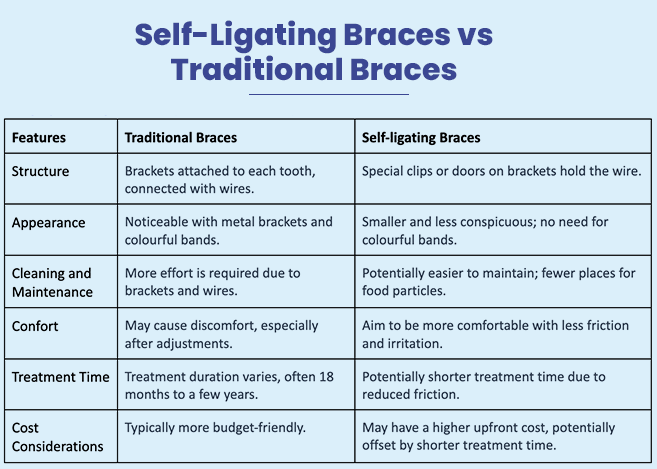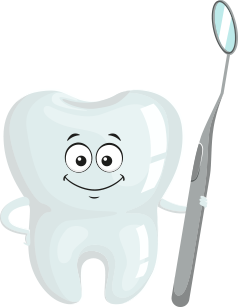Self-Ligating Braces vs Traditional Braces – Know the Difference

When it comes to getting braces, it’s like entering a whole new world. But before you take the step into a world of straighter smiles, it’s essential to understand the two main types of braces – Self-Ligating Braces and Traditional Braces. If you don’t know about these types of braces, we have got you covered.
In this blog, we’ll break down the key differences between Self-ligating braces vs Traditional braces so that you can make an informed decision for your pearly white smile.
What are Self-Ligating Braces and Traditional Braces?
Traditional Braces – These are the classic braces you’ve probably seen on many smiles. They have brackets attached to each tooth and are connected with wires. Tiny elastic bands, also known as ligatures, hold the wire in place on each bracket.
Self-Ligating Braces – These braces, however, are a little more modern in design. On the brackets holding the wire, there are unique clips or doors in place of those elastic bands. The goal of this design is to minimise friction, which may result in fewer appointments for adjustments.
Self-Ligating Braces vs Traditional Braces

Appearance – The Look Factor
Traditional Braces – Traditional braces are noticeable, and the metal brackets and colourful bands can make a bold statement. Some people embrace it, choosing bands in their favourite colours, while others may feel a bit self-conscious about the attention.
Self-Ligating Braces – Self-ligating braces are generally smaller and less noticeable. Since they don’t need those colourful bands, they may be a more modest choice if you’re concerned about the appearance of your braces.
Cleaning and Maintenance
Traditional Braces – Keeping traditional braces clean requires some effort. The brackets and wires create more nooks and notches for food to get stuck. Brushing and flossing may take a bit more time and care.
Self-Ligating Braces – Self-ligating braces could be a bit easier to maintain because of their design. Without the bands, there are fewer places for food particles to hide. Still, good oral hygiene practices remain crucial.
Comfort – The Feel Factor
Traditional Braces – Some people might experience discomfort, especially right after adjustments. The brackets and wires can rub against the cheeks and lips, causing irritation. Wax is usually used to alleviate this.
Self-Ligating Braces – These braces aim to be more comfortable because they have less friction. The absence of bands means less rubbing and irritation. However, it’s essential to remember that any braces might cause some discomfort, especially after adjustments.
Treatment Time
Traditional Braces – While the duration of treatment for traditional braces can vary, it typically lasts anywhere from 18 months to a few years. It takes constant adjustments to make sure everything is heading in the right direction.
Self-Ligating Braces – When compared to traditional braces, self-ligating braces may require a little less time for treatment. The possibility of a quicker process can be attributed to the decreased friction and the increased flexibility to make significant adjustments during appointments.
Cost Considerations
Traditional Braces – In general, traditional braces are less expensive. The result of the familiarity of the method and the materials used is often a lower total cost.
Self-Ligating Braces –While self-ligating braces might have a higher upfront cost, some claim that the potential for a shorter treatment time could balance the financial scale.
Conclusion – Making the Right Choice for You
The decision between self-ligating and traditional braces is based on affordability, comfort level, and personal taste. Traditional orthodontic braces have endured over time, achieving positive outcomes for many kinds of smiles. However, self-ligating braces provide a modern twist, with the goal of a more comfortable fit and possibly a shorter course of treatment.
Talk to your orthodontist, get their expert advice, and consider what factors matter most to you. You should visit Radiant Dental Care, the best braces treatment in Chennai, to get expert advice. We have a professional team who are here to help you in every manner they can. Book an appointment at the famous dental hospital in Chennai today at +91 9176166789.
FAQs
FAQ 1: What are self-ligating braces and traditional braces?
Answer: Traditional braces have metal brackets and colourful bands that connect with wires. Self-ligating braces are more modern, with special clips or doors on brackets holding the wire. They aim to reduce friction and might need fewer adjustment appointments.
FAQ 2: Do braces affect how my smile looks?
Answer: Yes, they can. Traditional braces are noticeable with metal brackets and colourful bands while self-ligating braces are smaller and less conspicuous. If you’re concerned about appearance, self-ligating braces might be a more subtle choice.
FAQ 3: Are braces uncomfortable?
Answer: Traditional braces might cause discomfort, especially after adjustments, as the brackets and wires can rub against the cheeks and lips. Self-ligating braces aim to be more comfortable due to less friction and irritation, but some discomfort is normal, especially after adjustments.
FAQ 4: How long does the treatment take, and which is more affordable?
Answer: The treatment time with traditional braces varies but often lasts between 18 months to a few years. Self-ligating braces may have a slightly shorter treatment time. Traditional braces are typically more budget-friendly, while self-ligating braces might have a higher upfront cost, potentially balanced by a shorter treatment time.

 +91 9513446186
+91 9513446186
